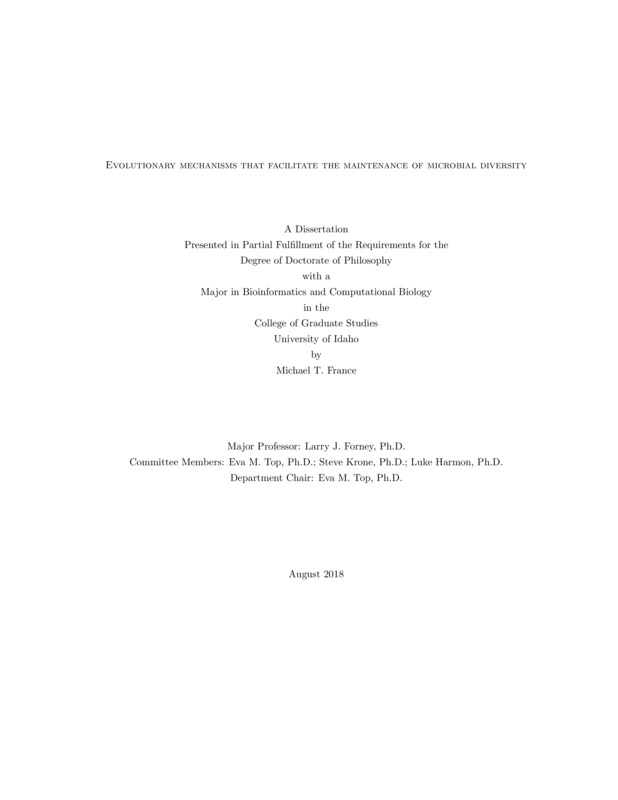Evolutionary Mechanisms that Facilitate the Maintenance of Microbial Diversity
France, Michael Timothy. (2018-08). Evolutionary Mechanisms that Facilitate the Maintenance of Microbial Diversity. Theses and Dissertations Collection, University of Idaho Library Digital Collections. https://www.lib.uidaho.edu/digital/etd/items/france_idaho_0089e_11337.html
- Title:
- Evolutionary Mechanisms that Facilitate the Maintenance of Microbial Diversity
- Author:
- France, Michael Timothy
- Date:
- 2018-08
- Keywords:
- Antibiotic resistance Biofilms Microbial Diversity Mutation Slow growth Spatial Structure
- Program:
- Bioinformatics & Computational Biology
- Subject Category:
- Microbiology; Evolution & development; Ecology
- Abstract:
-
Bacterial populations in the environment have been shown to harbor tremendous within species diversity. This diversity is important because it drives the evolution and ecology of these populations. It is the toolbox from which solutions to novel problems can be drawn. While several mechanisms have been proposed previously, it is still not clear how diversity is created and maintained in environmental bacterial populations. Bacteria typically live and evolve in environments that have physical structure. Their rate of growth is constrained by the abundance of routinely scarce essential nutrients, leading to generation times measured in days or weeks. I hypothesized that prolonged generation times and spatial structure would protract selective sweeps and limit competition to a local scale, allowing for the accumulation of genetic diversity via spontaneous mutations. In Chapter 2 I review our current knowledge of how spatial structure and slow growth rates influence the evolution of bacterial populations. I put my hypothesis to the test in Chapters 3 and 4, wherein I detail the effects of spatial structure and slow growth rates, respectively, on the accumulation and maintenance of diversity in bacterial populations. In Chapter 5 I employ the concepts detailed above in order to investigate the evolution of antibiotic resistance in bacterial biofilms. Biofilms are bacterial assemblages held together by an extracellular matrix. They have spatial structure and contain large subpopulations that experience slow growth rates. Finally, in Chapter 6 I used genomic comparisons to characterize and compare the genetic diversity present within and between two closely related bacterial species. Together, these studies give new insight into how
diversity is created and maintained in environmental bacterial populations.
- Description:
- doctoral, Ph.D., Bioinformatics & Computational Biology -- University of Idaho - College of Graduate Studies, 2018-08
- Major Professor:
- Forney, Larry J
- Committee:
- Top, Eva M; Harmon, Luke J; Krone, Steve M
- Defense Date:
- 2018-08
- Identifier:
- France_idaho_0089E_11337
- Type:
- Text
- Format Original:
- Format:
- application/pdf
- Rights:
- In Copyright - Educational Use Permitted. For more information, please contact University of Idaho Library Special Collections and Archives Department at libspec@uidaho.edu.
- Standardized Rights:
- http://rightsstatements.org/vocab/InC-EDU/1.0/

